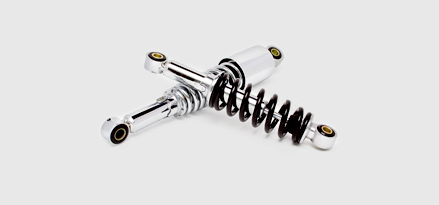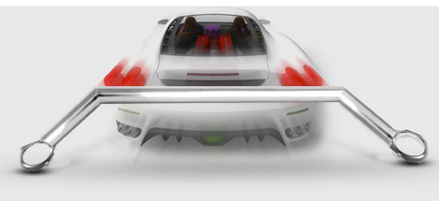Improving the handling of your ride
Attack those corners with lesser roll and greater confidence.
Handling problems have constantly plagued drivers of high performance vehicles who wish to achieve better lap times and improved handling characteristics from their rides. Regardless if you're into drifting, drag races or time attack, predictive handling from your vehicle would allow you to perform at your best and outshine your competition.
Common problems faced by drivers of all types of vehicles would be body roll. Body roll can be described as the car leaning towards the outside of a curve due to the centrifugal force acting upon the car, and load transfer. Body roll interferes with the control which the driver has over his vehicles and one must wait for the car to finish leaning before he can fully judge the effect of his steering change. Such an occurrence would add to the delay before the car moves in the desired direction as well.
There are several factors which causes body roll and similarly, several solutions that one can take to reduce this unwanted roll. For a start, a good handling upgrade to counter body roll that is easily available regardless if you're driving a Japanese, Korean or European ride, is a set of coilovers.
A coilover is an automotive suspension device, short for "coil spring over strut" and consists of a shock absorber with a coil spring around it. Getting a feel of how shock absorbers work can help improve the quality of a car’s handling. Damping, ride height and spring rates are all customisable to suit your driving style. A higher center of gravity would result in increased body roll hence by lowering the ride height of your vehicle through the use of coilovers, you can expect to feel an immediate reduction in body roll.
Handling problems have constantly plagued drivers of high performance vehicles who wish to achieve better lap times and improved handling characteristics from their rides. Regardless if you're into drifting, drag races or time attack, predictive handling from your vehicle would allow you to perform at your best and outshine your competition.
Common problems faced by drivers of all types of vehicles would be body roll. Body roll can be described as the car leaning towards the outside of a curve due to the centrifugal force acting upon the car, and load transfer. Body roll interferes with the control which the driver has over his vehicles and one must wait for the car to finish leaning before he can fully judge the effect of his steering change. Such an occurrence would add to the delay before the car moves in the desired direction as well.
There are several factors which causes body roll and similarly, several solutions that one can take to reduce this unwanted roll. For a start, a good handling upgrade to counter body roll that is easily available regardless if you're driving a Japanese, Korean or European ride, is a set of coilovers.
A coilover is an automotive suspension device, short for "coil spring over strut" and consists of a shock absorber with a coil spring around it. Getting a feel of how shock absorbers work can help improve the quality of a car’s handling. Damping, ride height and spring rates are all customisable to suit your driving style. A higher center of gravity would result in increased body roll hence by lowering the ride height of your vehicle through the use of coilovers, you can expect to feel an immediate reduction in body roll.

As the factory suspension of most rides is setup with comfort in mind, they are designed to absorb the bumps of the road surface. In such a setup, softer springs are used for greater levels of comfort for the passengers. However these softer springs will result in increased body roll. Coilovers, which are designed with performance in mind, have harder springs which cope better with load transfer when going through a bend and in turn, reducing body roll.
Anti-roll bars, as their name suggests, also aid in reducing the body roll of a vehicle. An anti-roll bar forms part of the vehicle suspension system by connecting the opposite wheels and increasing its resistance to roll in turns. Through its stiffness which is based on the thickness of the bar, it is able to resist body roll motions and in turn allow for better handling of the vehicle.
Now that we've dealt with body roll, the next installment shall explore the other handling improvements you can make to your ride.
In the second part of our guide to handling upgrades for your ride, we turn the spotlight onto strengthening the chassis of your vehicle through the use of various purpose-made bars.
A typical car chassis is supported by four wheels and four shock absorbers. These shock absorbers serve to ensure the comfort of the passengers by absorbing the imperfections and bumps found on most roads. However, certain chassis, due to either design or age, may not be structurally sound enough to support the shock absorbers. This would result in the impact of the bumps being partially absorbed by the chassis instead. Likewise, when navigating a high speed bend, the centrifugal force which causes the car to lean towards the outside of a curve will cause flex in the chassis due to the load transfer.
An understanding of how shock absorbers work shows that in theory, such lack of rigidity should not exist as it is a sign of structural weakness and hampers the efficiency of the vehicle's suspension. Such chassis flex will, over time, result in fatigue and eventually failure. In addition, such flexing will result in inconsistent handling characteristics from the vehicle.
A basic solution to correct such chassis flex is to install strut bars which tie the two parallel strut towers together. Such strut bars can be installed on both the front and the rear strut towers and they serve to provide extra stiffness between them. When taking a corner, the shock absorber may not fully absorb the impact of the load transfer. This would result in the shock tower, which forms part of the chassis, having to absorb part of the impact as well. By tying the two strut towers together, it reduces the flexing by distributing the impact to both towers instead of just merely one.
Anti-roll bars, as their name suggests, also aid in reducing the body roll of a vehicle. An anti-roll bar forms part of the vehicle suspension system by connecting the opposite wheels and increasing its resistance to roll in turns. Through its stiffness which is based on the thickness of the bar, it is able to resist body roll motions and in turn allow for better handling of the vehicle.
Now that we've dealt with body roll, the next installment shall explore the other handling improvements you can make to your ride.
In the second part of our guide to handling upgrades for your ride, we turn the spotlight onto strengthening the chassis of your vehicle through the use of various purpose-made bars.
A typical car chassis is supported by four wheels and four shock absorbers. These shock absorbers serve to ensure the comfort of the passengers by absorbing the imperfections and bumps found on most roads. However, certain chassis, due to either design or age, may not be structurally sound enough to support the shock absorbers. This would result in the impact of the bumps being partially absorbed by the chassis instead. Likewise, when navigating a high speed bend, the centrifugal force which causes the car to lean towards the outside of a curve will cause flex in the chassis due to the load transfer.
An understanding of how shock absorbers work shows that in theory, such lack of rigidity should not exist as it is a sign of structural weakness and hampers the efficiency of the vehicle's suspension. Such chassis flex will, over time, result in fatigue and eventually failure. In addition, such flexing will result in inconsistent handling characteristics from the vehicle.
A basic solution to correct such chassis flex is to install strut bars which tie the two parallel strut towers together. Such strut bars can be installed on both the front and the rear strut towers and they serve to provide extra stiffness between them. When taking a corner, the shock absorber may not fully absorb the impact of the load transfer. This would result in the shock tower, which forms part of the chassis, having to absorb part of the impact as well. By tying the two strut towers together, it reduces the flexing by distributing the impact to both towers instead of just merely one.

Undercarriage braces also serve to reduce chassis flex when your vehicle travels over uneven and bumpy roads. On such roads, the center section of the vehicle's chassis will experience different levels of flex caused by the weight transfer between the front and rear wheels. Such undercarriage braces are often attached to multiple points and serve a similar purpose of reducing chassis flex.
With coilovers, anti-roll bars, strut bars as well as undercarriage braces in place, you will instantly feel a huge improvement in how your vehicle handles. Steering response will be sharper and turn in more stable. Body roll will also be greatly reduced and you can also expect higher stability and grip in corners.
More often than not, the handling department often gets overlooked during the pursuit of raw power. But what good is 600Nm of torque when you eventually end up sliding all over the place due to extreme oversteer?
You may like to find out how Mobil 1™ benefits taxi drivers in Las Vegas despite the desert heat. Find out how Mobil 1™ protects your car in extreme temperature and high mileage.
This article is written by Leow Julen, contributing writer for Top Gear Singapore, and Samuel Kang, editor for Rev magazine.
With coilovers, anti-roll bars, strut bars as well as undercarriage braces in place, you will instantly feel a huge improvement in how your vehicle handles. Steering response will be sharper and turn in more stable. Body roll will also be greatly reduced and you can also expect higher stability and grip in corners.
More often than not, the handling department often gets overlooked during the pursuit of raw power. But what good is 600Nm of torque when you eventually end up sliding all over the place due to extreme oversteer?
You may like to find out how Mobil 1™ benefits taxi drivers in Las Vegas despite the desert heat. Find out how Mobil 1™ protects your car in extreme temperature and high mileage.
This article is written by Leow Julen, contributing writer for Top Gear Singapore, and Samuel Kang, editor for Rev magazine.
